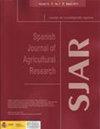灌溉管理和施氮的间断性优化了幼生菜的产量和水分利用效率
IF 0.8
4区 农林科学
Q3 AGRICULTURE, MULTIDISCIPLINARY
引用次数: 0
摘要
研究目的:评价不同灌溉管理策略和氮素对保护性环境下生菜幼苗生长、产量和水分利用效率的影响。 研究区域:巴西博图卡图(Botucatu) 材料与方法:试验连续两个周期进行,处理对应灌溉管理策略与施氮量相结合。灌溉策略包括三种可能性:连续灌溉(Cont);间歇灌溉,每隔1小时进行3次脉冲灌溉(Int1);间歇灌溉,灌溉深度分别在7:00、11:00、15:00进行(Int2)。根据不同的灌溉管理策略,对日施氮量分别为100和130 kg/ hm2进行了评价。主要结果:间歇灌溉策略(Int1和Int2)促进了植株的营养生长,提高了叶片含水量,提高了总产量(49.55和55.30);46.83和49.50吨/公顷)和适销产量(46.77和52.44;45.11 t/ha和47.17 t/ha),同时优化水利用效率。130 kg/ha施氮量仅在第一个作物周期提高了总产量(51.61 t/ha)、可售产量(48.98 t/ha)和总产量(53.60 kg/m³)和可售产量(50.88 kg/m³)的水分利用效率;研究的重点是:在灌溉管理中使用间歇性方法证明在获得高产量和最大限度地利用作为生产要素的水方面效率更高。本文章由计算机程序翻译,如有差异,请以英文原文为准。
Intermittence in irrigation management and nitrogen optimize yield and water use efficiency in baby lettuce
Aim of the study: To evaluate the influence of irrigation management strategies and nitrogen (N) on baby lettuce growth, yield, and water use efficiency in a protected environment.
Area of study: Botucatu, SP, Brazil.
Material and methods: The experiments were conducted in two consecutive cycles, and the treatments corresponded to the combination of irrigation management strategies with N doses. Irrigation strategies comprised 3 possibilities: continuous irrigation (Cont); intermittent irrigation with three irrigation pulses at one-hour intervals (Int1); and intermittent irrigation with irrigation depth split and applied at 7:00, 11:00, and 15:00 h (Int2). Two N doses were evaluated, 100 and 130 kg/ha of N, applied in daily fertigation according to the irrigation management strategies.
Main results: Intermittent irrigation strategies (Int1 and Int2) promoted the highest vegetative growth, increased leaf water content, and increased total yield (49.55 and 55.30; 46.83 and 49.50 t/ha) and marketable yield (46.77 and 52.44; 45.11 and 47.17 t/ha) in the first and second cycles, respectively, in addition to optimizing water use efficiency. The N dose of 130 kg/ha increased the total yield (51.61 t/ha), marketable yield (48.98 t/ha), and water use efficiencies of total yield (53.60 kg/m³) and marketable yield (50.88 kg/m³) only in the first crop cycle.
Research highlights: The use of intermittence in irrigation management proved to be more efficient in obtaining high yields and maximized the efficiency of use of water as a factor of production.
求助全文
通过发布文献求助,成功后即可免费获取论文全文。
去求助
来源期刊

Spanish Journal of Agricultural Research
农林科学-农业综合
CiteScore
2.00
自引率
0.00%
发文量
60
审稿时长
6 months
期刊介绍:
The Spanish Journal of Agricultural Research (SJAR) is a quarterly international journal that accepts research articles, reviews and short communications of content related to agriculture. Research articles and short communications must report original work not previously published in any language and not under consideration for publication elsewhere.
The main aim of SJAR is to publish papers that report research findings on the following topics: agricultural economics; agricultural engineering; agricultural environment and ecology; animal breeding, genetics and reproduction; animal health and welfare; animal production; plant breeding, genetics and genetic resources; plant physiology; plant production (field and horticultural crops); plant protection; soil science; and water management.
 求助内容:
求助内容: 应助结果提醒方式:
应助结果提醒方式:


